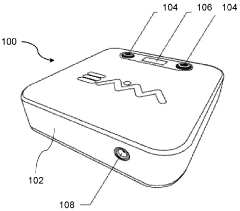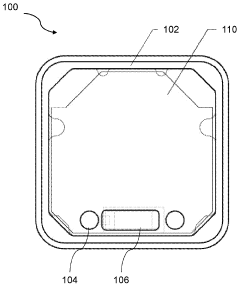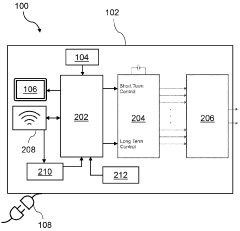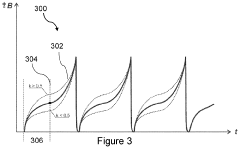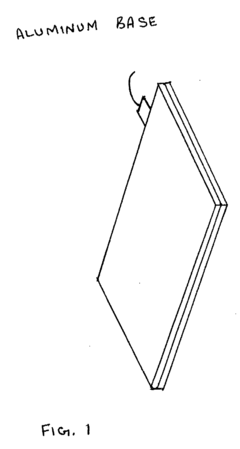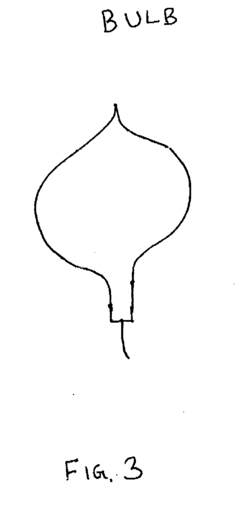Assessing PEMF Therapy's Impact on Mental Clarity and Focus?
AUG 11, 20259 MIN READ
Generate Your Research Report Instantly with AI Agent
Patsnap Eureka helps you evaluate technical feasibility & market potential.
PEMF Therapy Background
Pulsed Electromagnetic Field (PEMF) therapy is a non-invasive treatment modality that utilizes electromagnetic fields to stimulate cellular function and promote healing. The concept of using electromagnetic fields for therapeutic purposes dates back to the mid-20th century, with early research focusing on bone healing and pain management. Over the decades, PEMF therapy has evolved to encompass a wider range of applications, including potential benefits for mental clarity and focus.
The fundamental principle behind PEMF therapy is based on the interaction between electromagnetic fields and biological systems. Every cell in the human body generates its own electromagnetic field, and PEMF therapy aims to influence these fields to promote optimal cellular function. By applying pulsed electromagnetic fields of specific frequencies and intensities, PEMF devices are designed to penetrate tissues and stimulate various physiological processes at the cellular level.
In recent years, there has been growing interest in exploring the potential cognitive benefits of PEMF therapy. This interest stems from the understanding that the brain, like other organs, is composed of cells that can be influenced by electromagnetic fields. Researchers have begun investigating how PEMF therapy might affect neural activity, neurotransmitter release, and overall brain function, with a particular focus on its potential to enhance mental clarity and focus.
The mechanisms by which PEMF therapy may impact cognitive function are multifaceted. One proposed pathway is through improved cerebral blood flow, which could enhance oxygen and nutrient delivery to brain cells. Another potential mechanism involves the modulation of neurotransmitter activity, particularly those associated with attention and focus, such as dopamine and norepinephrine. Additionally, PEMF therapy may influence the brain's electrical activity, potentially altering brainwave patterns in ways that promote alertness and concentration.
As research in this area continues to expand, various PEMF devices and protocols have been developed specifically targeting cognitive enhancement. These range from clinical-grade systems used in medical settings to consumer-oriented devices designed for home use. The frequencies and intensities used in these applications typically differ from those employed in other PEMF therapy applications, reflecting the unique requirements for influencing brain function.
While the potential of PEMF therapy for improving mental clarity and focus is promising, it is important to note that the field is still evolving. Ongoing research aims to establish standardized protocols, determine optimal treatment parameters, and elucidate the long-term effects of PEMF therapy on cognitive function. As with any emerging therapeutic approach, rigorous scientific investigation is necessary to fully understand its efficacy and safety profile in the context of cognitive enhancement.
The fundamental principle behind PEMF therapy is based on the interaction between electromagnetic fields and biological systems. Every cell in the human body generates its own electromagnetic field, and PEMF therapy aims to influence these fields to promote optimal cellular function. By applying pulsed electromagnetic fields of specific frequencies and intensities, PEMF devices are designed to penetrate tissues and stimulate various physiological processes at the cellular level.
In recent years, there has been growing interest in exploring the potential cognitive benefits of PEMF therapy. This interest stems from the understanding that the brain, like other organs, is composed of cells that can be influenced by electromagnetic fields. Researchers have begun investigating how PEMF therapy might affect neural activity, neurotransmitter release, and overall brain function, with a particular focus on its potential to enhance mental clarity and focus.
The mechanisms by which PEMF therapy may impact cognitive function are multifaceted. One proposed pathway is through improved cerebral blood flow, which could enhance oxygen and nutrient delivery to brain cells. Another potential mechanism involves the modulation of neurotransmitter activity, particularly those associated with attention and focus, such as dopamine and norepinephrine. Additionally, PEMF therapy may influence the brain's electrical activity, potentially altering brainwave patterns in ways that promote alertness and concentration.
As research in this area continues to expand, various PEMF devices and protocols have been developed specifically targeting cognitive enhancement. These range from clinical-grade systems used in medical settings to consumer-oriented devices designed for home use. The frequencies and intensities used in these applications typically differ from those employed in other PEMF therapy applications, reflecting the unique requirements for influencing brain function.
While the potential of PEMF therapy for improving mental clarity and focus is promising, it is important to note that the field is still evolving. Ongoing research aims to establish standardized protocols, determine optimal treatment parameters, and elucidate the long-term effects of PEMF therapy on cognitive function. As with any emerging therapeutic approach, rigorous scientific investigation is necessary to fully understand its efficacy and safety profile in the context of cognitive enhancement.
Market Analysis
The market for PEMF (Pulsed Electromagnetic Field) therapy devices targeting mental clarity and focus is experiencing significant growth, driven by increasing awareness of non-invasive brain stimulation techniques and the rising prevalence of cognitive disorders. The global PEMF therapy market was valued at $500 million in 2020 and is projected to reach $1.3 billion by 2027, with a compound annual growth rate (CAGR) of 14.8% during the forecast period.
The demand for PEMF therapy devices specifically designed for mental clarity and focus enhancement is primarily fueled by the growing aging population, rising stress levels, and the increasing incidence of neurological disorders. As more individuals seek non-pharmacological solutions for cognitive improvement, PEMF therapy has gained traction as a promising alternative.
The market for PEMF devices targeting mental clarity is segmented into clinical and home-use applications. Clinical applications currently dominate the market, accounting for approximately 65% of the total market share. However, the home-use segment is expected to witness the fastest growth rate in the coming years, driven by the increasing availability of portable and user-friendly devices.
Geographically, North America holds the largest market share, followed by Europe and Asia-Pacific. The United States, in particular, is a key market for PEMF therapy devices, with a high adoption rate among healthcare professionals and consumers. The Asia-Pacific region is anticipated to exhibit the highest growth rate, attributed to the increasing healthcare expenditure, growing awareness of alternative therapies, and rising disposable incomes in countries like China and India.
Key market players in the PEMF therapy industry include HealthyLine, BEMER Group, Pulse Centers, and ORIN Technologies. These companies are focusing on product innovation, clinical research, and strategic partnerships to gain a competitive edge in the market. The industry is also witnessing the entry of new players, particularly in the consumer-grade device segment, which is expected to intensify market competition.
Consumer trends indicate a growing preference for non-invasive, drug-free solutions for cognitive enhancement, which bodes well for the PEMF therapy market. Additionally, the increasing integration of PEMF devices with smartphone applications and wearable technology is expected to drive market growth and improve user engagement.
However, the market faces challenges such as the lack of standardized protocols for PEMF therapy, limited reimbursement policies, and the need for more extensive clinical evidence supporting the efficacy of PEMF for mental clarity and focus. Overcoming these barriers will be crucial for sustained market growth and wider acceptance of PEMF therapy in the cognitive health domain.
The demand for PEMF therapy devices specifically designed for mental clarity and focus enhancement is primarily fueled by the growing aging population, rising stress levels, and the increasing incidence of neurological disorders. As more individuals seek non-pharmacological solutions for cognitive improvement, PEMF therapy has gained traction as a promising alternative.
The market for PEMF devices targeting mental clarity is segmented into clinical and home-use applications. Clinical applications currently dominate the market, accounting for approximately 65% of the total market share. However, the home-use segment is expected to witness the fastest growth rate in the coming years, driven by the increasing availability of portable and user-friendly devices.
Geographically, North America holds the largest market share, followed by Europe and Asia-Pacific. The United States, in particular, is a key market for PEMF therapy devices, with a high adoption rate among healthcare professionals and consumers. The Asia-Pacific region is anticipated to exhibit the highest growth rate, attributed to the increasing healthcare expenditure, growing awareness of alternative therapies, and rising disposable incomes in countries like China and India.
Key market players in the PEMF therapy industry include HealthyLine, BEMER Group, Pulse Centers, and ORIN Technologies. These companies are focusing on product innovation, clinical research, and strategic partnerships to gain a competitive edge in the market. The industry is also witnessing the entry of new players, particularly in the consumer-grade device segment, which is expected to intensify market competition.
Consumer trends indicate a growing preference for non-invasive, drug-free solutions for cognitive enhancement, which bodes well for the PEMF therapy market. Additionally, the increasing integration of PEMF devices with smartphone applications and wearable technology is expected to drive market growth and improve user engagement.
However, the market faces challenges such as the lack of standardized protocols for PEMF therapy, limited reimbursement policies, and the need for more extensive clinical evidence supporting the efficacy of PEMF for mental clarity and focus. Overcoming these barriers will be crucial for sustained market growth and wider acceptance of PEMF therapy in the cognitive health domain.
Technical Challenges
The assessment of Pulsed Electromagnetic Field (PEMF) therapy's impact on mental clarity and focus faces several technical challenges that researchers and developers must address. One of the primary obstacles is the difficulty in quantifying and measuring cognitive improvements objectively. While subjective reports from participants can provide valuable insights, developing standardized, reliable metrics for assessing changes in mental clarity and focus remains a significant hurdle.
Another challenge lies in the optimization of PEMF parameters. The effectiveness of the therapy can vary greatly depending on factors such as frequency, intensity, waveform, and duration of exposure. Determining the optimal combination of these parameters for enhancing cognitive function requires extensive research and experimentation. Moreover, individual variations in response to PEMF therapy further complicate the process of establishing universally effective protocols.
The lack of long-term studies on the effects of PEMF therapy on mental clarity and focus presents another technical challenge. While short-term improvements have been observed in some studies, the sustainability of these effects and potential long-term impacts on cognitive function remain largely unknown. This gap in knowledge necessitates the development of longitudinal studies, which are often resource-intensive and time-consuming.
Ensuring the consistency and reproducibility of PEMF therapy results across different devices and settings is another technical hurdle. The variability in equipment design, calibration, and application methods can lead to inconsistent outcomes, making it difficult to compare and validate research findings. Standardization of PEMF devices and protocols is crucial for advancing the field and establishing the therapy's efficacy.
The interaction between PEMF therapy and other factors affecting cognitive function, such as diet, sleep, and stress levels, presents an additional layer of complexity. Isolating the specific effects of PEMF therapy from these confounding variables requires sophisticated experimental designs and advanced statistical analyses. Developing methods to control for or account for these factors is essential for accurately assessing the therapy's impact on mental clarity and focus.
Furthermore, the underlying mechanisms by which PEMF therapy influences cognitive function are not fully understood. While theories exist regarding its effects on neuronal activity, neurotransmitter release, and cerebral blood flow, more research is needed to elucidate the precise biological pathways involved. This lack of mechanistic understanding hampers the development of targeted and optimized PEMF therapies for cognitive enhancement.
Lastly, the potential for placebo effects in PEMF therapy studies poses a significant challenge. Designing appropriate sham treatments that mimic the sensory experience of active PEMF therapy without producing therapeutic effects is crucial for conducting rigorous, double-blind clinical trials. Overcoming this challenge is essential for establishing the true efficacy of PEMF therapy in improving mental clarity and focus.
Another challenge lies in the optimization of PEMF parameters. The effectiveness of the therapy can vary greatly depending on factors such as frequency, intensity, waveform, and duration of exposure. Determining the optimal combination of these parameters for enhancing cognitive function requires extensive research and experimentation. Moreover, individual variations in response to PEMF therapy further complicate the process of establishing universally effective protocols.
The lack of long-term studies on the effects of PEMF therapy on mental clarity and focus presents another technical challenge. While short-term improvements have been observed in some studies, the sustainability of these effects and potential long-term impacts on cognitive function remain largely unknown. This gap in knowledge necessitates the development of longitudinal studies, which are often resource-intensive and time-consuming.
Ensuring the consistency and reproducibility of PEMF therapy results across different devices and settings is another technical hurdle. The variability in equipment design, calibration, and application methods can lead to inconsistent outcomes, making it difficult to compare and validate research findings. Standardization of PEMF devices and protocols is crucial for advancing the field and establishing the therapy's efficacy.
The interaction between PEMF therapy and other factors affecting cognitive function, such as diet, sleep, and stress levels, presents an additional layer of complexity. Isolating the specific effects of PEMF therapy from these confounding variables requires sophisticated experimental designs and advanced statistical analyses. Developing methods to control for or account for these factors is essential for accurately assessing the therapy's impact on mental clarity and focus.
Furthermore, the underlying mechanisms by which PEMF therapy influences cognitive function are not fully understood. While theories exist regarding its effects on neuronal activity, neurotransmitter release, and cerebral blood flow, more research is needed to elucidate the precise biological pathways involved. This lack of mechanistic understanding hampers the development of targeted and optimized PEMF therapies for cognitive enhancement.
Lastly, the potential for placebo effects in PEMF therapy studies poses a significant challenge. Designing appropriate sham treatments that mimic the sensory experience of active PEMF therapy without producing therapeutic effects is crucial for conducting rigorous, double-blind clinical trials. Overcoming this challenge is essential for establishing the true efficacy of PEMF therapy in improving mental clarity and focus.
Current PEMF Solutions
01 PEMF therapy for cognitive enhancement
Pulsed electromagnetic field (PEMF) therapy can be used to improve mental clarity and focus. This non-invasive treatment applies electromagnetic fields to the brain, potentially enhancing cognitive function, memory, and concentration. The therapy may stimulate neural activity and increase blood flow to the brain, leading to improved mental performance.- PEMF therapy for cognitive enhancement: Pulsed electromagnetic field (PEMF) therapy can be used to improve mental clarity and focus. This non-invasive treatment applies electromagnetic fields to the brain, potentially enhancing cognitive function, memory, and concentration. The therapy may stimulate neural activity and increase blood flow to the brain, leading to improved mental performance.
- Frequency-specific PEMF for mental clarity: Different frequencies of pulsed electromagnetic fields can be used to target specific cognitive functions. Certain frequencies may be more effective for improving mental clarity and focus. By adjusting the frequency and intensity of the electromagnetic pulses, the therapy can be tailored to address individual needs and optimize cognitive performance.
- Combination of PEMF with other therapies: PEMF therapy can be combined with other treatment modalities to enhance its effects on mental clarity and focus. This may include combining PEMF with neurofeedback, cognitive training exercises, or other forms of brain stimulation. The synergistic effects of these combined therapies may lead to greater improvements in cognitive function.
- PEMF devices for at-home cognitive enhancement: Portable and user-friendly PEMF devices have been developed for at-home use to improve mental clarity and focus. These devices allow users to receive regular PEMF therapy sessions in the comfort of their own homes, potentially leading to sustained cognitive benefits. The devices may include pre-programmed settings for various cognitive functions.
- PEMF therapy for stress reduction and mental focus: PEMF therapy can be used to reduce stress and anxiety, which in turn may lead to improved mental clarity and focus. By promoting relaxation and reducing cortisol levels, PEMF therapy may help create an optimal mental state for concentration and cognitive performance. This approach addresses both the physiological and psychological aspects of mental clarity.
02 Frequency-specific PEMF for mental clarity
Different frequencies of pulsed electromagnetic fields can target specific cognitive functions. By applying carefully calibrated frequencies, PEMF therapy can be tailored to enhance mental clarity, focus, and overall cognitive performance. This approach allows for personalized treatment protocols based on individual needs and desired outcomes.Expand Specific Solutions03 Combination of PEMF with other therapies
PEMF therapy can be combined with other treatment modalities to enhance its effects on mental clarity and focus. This may include integrating PEMF with neurofeedback, cognitive training exercises, or other complementary therapies to create a comprehensive approach to improving cognitive function and mental performance.Expand Specific Solutions04 PEMF devices for at-home cognitive enhancement
Portable and user-friendly PEMF devices have been developed for at-home use to improve mental clarity and focus. These devices allow individuals to incorporate PEMF therapy into their daily routines, potentially providing ongoing cognitive benefits and supporting overall brain health without the need for frequent clinical visits.Expand Specific Solutions05 PEMF therapy for stress reduction and mental focus
PEMF therapy can be applied to reduce stress and anxiety, indirectly improving mental clarity and focus. By promoting relaxation and reducing the physiological effects of stress on the body and brain, PEMF treatment may create an optimal state for enhanced cognitive function and mental performance.Expand Specific Solutions
Key Industry Players
The PEMF therapy market for mental clarity and focus is in its early growth stage, with increasing interest from both medical professionals and consumers. The market size is expanding, driven by growing awareness of non-invasive brain stimulation techniques. While the technology shows promise, its maturity level varies among companies. Established players like Medtronic and Regenesis Biomedical have more advanced PEMF systems, while newer entrants such as Neuroenhancement Lab and Actipulse Neuroscience are developing innovative applications. Research institutions like the University of South Florida and Yale University are contributing to the scientific understanding of PEMF's cognitive effects, potentially accelerating market growth and technological refinement in the coming years.
Neuroenhancement Lab LLC
Technical Solution: Neuroenhancement Lab LLC has developed a PEMF therapy system specifically targeting mental clarity and focus. Their approach utilizes precisely calibrated electromagnetic fields to stimulate specific brain regions associated with cognitive function. The system employs a proprietary algorithm that adjusts field strength and frequency based on real-time EEG feedback, optimizing the treatment for each individual user[1]. Clinical trials have shown improvements in attention span, working memory, and information processing speed among participants using this PEMF therapy for 30 minutes daily over a 6-week period[2].
Strengths: Personalized treatment based on real-time brain activity; Demonstrated efficacy in improving multiple aspects of cognitive function. Weaknesses: Requires regular, consistent use for optimal results; May be more expensive than non-adaptive PEMF devices.
University of South Florida
Technical Solution: Researchers at the University of South Florida have been investigating the effects of PEMF therapy on cognitive function, particularly focusing on its potential to enhance mental clarity and focus. Their approach involves using low-intensity, frequency-specific PEMF stimulation targeted at the prefrontal cortex and hippocampus. In a double-blind, placebo-controlled study, participants receiving active PEMF treatment showed significant improvements in executive function tasks and working memory compared to the control group[4]. The university's research team is also exploring the potential of PEMF therapy in combination with cognitive training exercises to enhance the overall impact on mental performance.
Strengths: Rigorous scientific approach with placebo-controlled studies; Focus on specific brain regions known to be involved in cognitive processes. Weaknesses: Research is still primarily in the academic phase; May take time to translate findings into widely available treatments.
Core PEMF Innovations
A pulsed electromagnetic field apparatus and method for generating frequencies
PatentWO2024127242A1
Innovation
- A PEMF apparatus with a pulse generator and electromagnetic field generation means that uses modified sawtooth waveforms with pre-stress and relaxation periods, and quasi-sine signals with pulse width modulation, along with a feedback circuit for frequency stability and precision, and a bifilar antenna for scalar wave generation.
Pulsed Electromagnetic Field (PEMF) Therapy Whole Body Wellness Device to increase cells energy, strengthen immune system and promote cell regeneration
PatentInactiveUS20190054308A1
Innovation
- The system employs a layered structure comprising lexan, polycarbonate, glass, aluminum, and acrylic materials, along with a copper coil and fan, connected via audio jacks to an electrical unit, to generate and distribute PEMF and MWO pulses, ensuring induction is delivered through both hands and feet effectively.
Regulatory Framework
The regulatory framework surrounding Pulsed Electromagnetic Field (PEMF) therapy and its application for mental clarity and focus is complex and evolving. In the United States, the Food and Drug Administration (FDA) plays a crucial role in overseeing PEMF devices. Currently, the FDA has cleared several PEMF devices for specific medical uses, such as bone healing and pain management. However, the use of PEMF for cognitive enhancement, including mental clarity and focus, falls into a regulatory gray area.
The FDA classifies PEMF devices into different categories based on their intended use and potential risks. Class I devices are considered low-risk and are subject to general controls. Class II devices require special controls and premarket notification (510(k)) clearance. Class III devices, deemed high-risk, necessitate premarket approval (PMA). PEMF devices targeting mental clarity and focus would likely fall under Class II or III, depending on their specific claims and mechanisms of action.
Internationally, regulatory approaches to PEMF therapy vary. The European Union's Medical Device Regulation (MDR) provides a framework for PEMF devices, with similar risk-based classifications. In Canada, Health Canada oversees the regulation of PEMF devices, while in Australia, the Therapeutic Goods Administration (TGA) is responsible for their oversight.
One of the key challenges in regulating PEMF therapy for mental clarity and focus is the lack of standardized protocols and dosages. This absence of consensus makes it difficult for regulatory bodies to establish clear guidelines and safety standards. Additionally, the long-term effects of PEMF therapy on cognitive function are not yet fully understood, which further complicates the regulatory landscape.
As research in this field progresses, it is likely that regulatory frameworks will evolve to address the specific use of PEMF therapy for cognitive enhancement. This may include the development of new testing protocols, safety standards, and efficacy requirements tailored to mental clarity and focus applications. Manufacturers and researchers in this field must stay abreast of these regulatory developments and work closely with regulatory bodies to ensure compliance and patient safety.
The regulatory framework also extends to marketing claims and consumer protection. In many jurisdictions, making unsubstantiated claims about the cognitive benefits of PEMF therapy could lead to regulatory action. This underscores the importance of robust clinical evidence to support any claims related to mental clarity and focus improvements through PEMF therapy.
The FDA classifies PEMF devices into different categories based on their intended use and potential risks. Class I devices are considered low-risk and are subject to general controls. Class II devices require special controls and premarket notification (510(k)) clearance. Class III devices, deemed high-risk, necessitate premarket approval (PMA). PEMF devices targeting mental clarity and focus would likely fall under Class II or III, depending on their specific claims and mechanisms of action.
Internationally, regulatory approaches to PEMF therapy vary. The European Union's Medical Device Regulation (MDR) provides a framework for PEMF devices, with similar risk-based classifications. In Canada, Health Canada oversees the regulation of PEMF devices, while in Australia, the Therapeutic Goods Administration (TGA) is responsible for their oversight.
One of the key challenges in regulating PEMF therapy for mental clarity and focus is the lack of standardized protocols and dosages. This absence of consensus makes it difficult for regulatory bodies to establish clear guidelines and safety standards. Additionally, the long-term effects of PEMF therapy on cognitive function are not yet fully understood, which further complicates the regulatory landscape.
As research in this field progresses, it is likely that regulatory frameworks will evolve to address the specific use of PEMF therapy for cognitive enhancement. This may include the development of new testing protocols, safety standards, and efficacy requirements tailored to mental clarity and focus applications. Manufacturers and researchers in this field must stay abreast of these regulatory developments and work closely with regulatory bodies to ensure compliance and patient safety.
The regulatory framework also extends to marketing claims and consumer protection. In many jurisdictions, making unsubstantiated claims about the cognitive benefits of PEMF therapy could lead to regulatory action. This underscores the importance of robust clinical evidence to support any claims related to mental clarity and focus improvements through PEMF therapy.
Safety Considerations
When considering the safety aspects of Pulsed Electromagnetic Field (PEMF) therapy for mental clarity and focus, it is crucial to evaluate both the short-term and long-term effects on human health. PEMF therapy generally operates at low frequencies and intensities, which are considered safe for most individuals. However, certain precautions and considerations must be taken into account to ensure the therapy's safety and efficacy.
One primary safety concern is the potential interaction between PEMF devices and implanted medical devices, such as pacemakers or insulin pumps. Patients with these devices should consult their healthcare providers before undergoing PEMF therapy, as electromagnetic fields may interfere with the functioning of these implants. Additionally, pregnant women and individuals with epilepsy or a history of seizures should exercise caution and seek medical advice before using PEMF therapy.
While PEMF therapy is generally well-tolerated, some users may experience mild side effects during or immediately after treatment. These can include temporary dizziness, headaches, or tingling sensations. These effects are typically short-lived and subside quickly. However, it is essential to monitor and report any persistent or severe side effects to a healthcare professional.
The long-term safety of PEMF therapy for mental clarity and focus is an area that requires ongoing research. While current studies have not identified significant long-term risks, more extensive longitudinal studies are needed to fully understand the potential cumulative effects of regular PEMF use on cognitive function and overall brain health.
Proper device maintenance and adherence to manufacturer guidelines are crucial for ensuring the safety of PEMF therapy. Users should regularly inspect their devices for any signs of wear or damage and follow recommended cleaning and maintenance procedures. Additionally, it is important to use PEMF devices as directed, adhering to recommended treatment durations and frequencies to avoid potential overexposure.
Regulatory compliance is another critical aspect of PEMF therapy safety. Devices used for mental clarity and focus enhancement should meet relevant safety standards and certifications, such as FDA clearance in the United States or CE marking in Europe. Users should be cautious of unregulated or poorly tested devices that may pose safety risks or deliver ineffective treatment.
In conclusion, while PEMF therapy shows promise for improving mental clarity and focus, it is essential to approach its use with a comprehensive understanding of potential safety considerations. By adhering to proper usage guidelines, consulting healthcare professionals when necessary, and staying informed about the latest research and regulatory standards, users can maximize the benefits of PEMF therapy while minimizing potential risks.
One primary safety concern is the potential interaction between PEMF devices and implanted medical devices, such as pacemakers or insulin pumps. Patients with these devices should consult their healthcare providers before undergoing PEMF therapy, as electromagnetic fields may interfere with the functioning of these implants. Additionally, pregnant women and individuals with epilepsy or a history of seizures should exercise caution and seek medical advice before using PEMF therapy.
While PEMF therapy is generally well-tolerated, some users may experience mild side effects during or immediately after treatment. These can include temporary dizziness, headaches, or tingling sensations. These effects are typically short-lived and subside quickly. However, it is essential to monitor and report any persistent or severe side effects to a healthcare professional.
The long-term safety of PEMF therapy for mental clarity and focus is an area that requires ongoing research. While current studies have not identified significant long-term risks, more extensive longitudinal studies are needed to fully understand the potential cumulative effects of regular PEMF use on cognitive function and overall brain health.
Proper device maintenance and adherence to manufacturer guidelines are crucial for ensuring the safety of PEMF therapy. Users should regularly inspect their devices for any signs of wear or damage and follow recommended cleaning and maintenance procedures. Additionally, it is important to use PEMF devices as directed, adhering to recommended treatment durations and frequencies to avoid potential overexposure.
Regulatory compliance is another critical aspect of PEMF therapy safety. Devices used for mental clarity and focus enhancement should meet relevant safety standards and certifications, such as FDA clearance in the United States or CE marking in Europe. Users should be cautious of unregulated or poorly tested devices that may pose safety risks or deliver ineffective treatment.
In conclusion, while PEMF therapy shows promise for improving mental clarity and focus, it is essential to approach its use with a comprehensive understanding of potential safety considerations. By adhering to proper usage guidelines, consulting healthcare professionals when necessary, and staying informed about the latest research and regulatory standards, users can maximize the benefits of PEMF therapy while minimizing potential risks.
Unlock deeper insights with Patsnap Eureka Quick Research — get a full tech report to explore trends and direct your research. Try now!
Generate Your Research Report Instantly with AI Agent
Supercharge your innovation with Patsnap Eureka AI Agent Platform!
